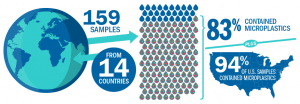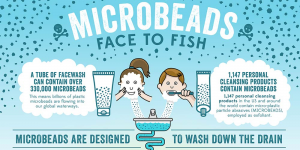The Issue
- We are constantly using products that contribute to microplastic pollution
- Since it is an understudied issue, there is little awareness being brought to the issue
- Microplastic pollution poses a huge threat to wildlife AND to humans
- Not enough is being done to stop this pollution
Why We Should Care?
Threat to Marine Life

- Toxic chemicals (POPs, PCBs, PAHs, and PBDEs) stick to the surface of microplastics at extremely high levels
- Many marine organisms (i.e., sharks, fish, turtles, shrimp, seahorses, sea lions) mistake these microplastics for food and eat them or eat an organism that has consumed them, causing these toxins to travel up the food chain
- After ingestion, these toxic chemicals leak into the tissues of the marine organisms
The Ocean Conference 2017

- The United Nations stated that approximately 80% of the debris in our oceans and seas consists of plastic
- Marine debris harms approximately 800 species (40% of which are marine animals and 44% of which are seabird species)
- These species are affected by such debris through ingestion
- Each year, plastic debris kills up to 1 million seabirds, 100,000 sea mammals, marine turtles and countless fish
Human Consumption
Results from Orb Media study:
- Microplastics found in honey, sugar, beer, water, bottled water (ex: Aquafina), and the air we breathe.
- Microplastics can attract bacteria, which is also ingested by and may kill sea life
- This deceased sea life may end up in U.S. markets and be consumed by humans, allowing the microplastics and bacteria to enter.

- Of 159 samples of drinking water, 83% contained microplastics. Of all nations tested, the U.S. was the most contaminated, displaying a 94% rate of drinking water being polluted by microplastics.
Human Health
- “Using a variety of cosmetics and personal care products is one of the most prominent ways our bodies are exposed to microplastics” (Beatthebead.org)
- They have been found in nail polishes, face creams and lotions, exfoliants, lipstick, and other beauty products
- Using creams can put about 90,000 plastic particles on your face of various sizes
- If these enter the body, they have the potential to damage parts of body such as the stomach and brain




